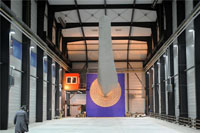Feb 17 2009
The development of wind energy utilization will primarily take place offshore. This is why many system manufacturers have moved their production to the coast. The IWES headquarters is located in Bremerhaven, close to the manufacturers. During the year 2009, the Institute for Solar Energy Supply Technology ISET, an association at the University of Kassel specializing in developing power grids for renewable sources, will be integrated into the IWES. Like all Fraunhofer institutes, the new one will also work closely with universities: in addition to its close ties to the University of Kassel, two Fraunhofer project groups will be set up, one at the University of Hanover and one at the University of Oldenburg. The University of Bremen is also cooperating with the IWES.

In keeping with the key significance of wind energy, both the federal government and the Länder that are homes to the Institute are strongly committed to developing the IWES. The German Federal Ministry of Education and Research and the Land of Bremen have already provided institutional funding to the predecessor of the IWES, the Fraunhofer Center for Wind Energy and Maritime Technologies CWMT; this support includes construction of research facilities totaling 12.8 million euros. The federal ministry for the environment, nature conservation and nuclear safety BMU and the Land of Bremen are currently providing funds of 12.6 million euros for the construction of the rotor blade competence center as a part of the IWES. The BMU has furthermore promised the IWES project funds of 25 million euros in the years 2009 through 2013. The Bremen Senate is providing 10 million euros in aid for further expansion of the IWES in Bremerhaven in the years through 2014. The Land of Niedersachsen is supporting not only the Fraunhofer project groups, but also the cooperating universities in Hannover and Oldenburg, likewise with funds in the tens of millions of euros. Hessen is funding the transition of the Kassel ISET into the IWES with 10.5 million euros, and also wants to share in the costs of new construction in Kassel for the medium term.
The human race's growing energy needs are one of the greatest challenges today: there is a demand for concepts for safely and economically supplying energy that is friendly to the environment and the climate. “We are rising to the challenges, developing wind power systems in more than 5 MW power class of for rough off-shore use, working on rugged power grids and much more. What we achieve today in research can be implemented swiftly and contributes to expanding the leading position of German companies,” explains Professor Hans-Jörg Bullinger, the President of the Fraunhofer-Gesellschaft.
Wind energy is already an economic factor today: total global sales in 2007 amounted to 15.4 billion euros. German manufacturers and suppliers, the market leaders, accounted for 37 percent of these sales. Sales of 24 to 30 billion euros are forecast for 2020 for German companies who develop renewable energy sources. Assuming that wind power supplies two-thirds of this energy as planned, this means sales of 16 to 20 billion euros.
“Global competition is intensifying in light of the rapidly growing market; this is forcing manufacturers of wind energy systems to develop innovations continually in order to remain competitive on the market,” adds Dr. Hans-Gerd Busmann, acting director of the IWES in Bremerhaven. “The pressure to innovate is particularly high in the offshore area: the systems must be planned and constructed in such a way that they withstand wind, weather and waves for years to decades.”
Manufacturers and operators of wind energy systems find competent contacts at the IWES: the researchers have already been developing testing methods for wind energy systems for two years: the CWMT, which has merged into the new Fraunhofer Institute IWES, has specialized in oversized material tests. A building 85 meters long and 25 meters high was constructed so that rotor blades could be tested. Dr. Arno van Wingerde from the IWES stresses, “Our test setup is one of the largest in the world. Rotor blade manufacturers are showing enormous interest in using the test stand.”
“Wind power will supply the lion's share of renewable energy in the coming decades. In combination with the other renewable energies, new storage technologies and intelligent energy management systems, we will be able to generate a large portion of the required electricity in 40 years. But only if we continue expanding wind power in conjunction with solar energy, bioenergy and ocean energy,” explains Prof. Jürgen Schmid, director of the ISET in Kassel.
In the future, the new Fraunhofer Institute will be home to experts from various disciplines. The engineers in Bremerhaven are contributing their experience in testing and simulation of materials and components, while the researchers from Kassel are working on electrotechnical issues. One of their special areas is the integration of wind-produced electricity into public power grids. “The groups complement each other wonderfully,” Busmann continues. “Together we can build a competence center that offers all services, from development and construction of the components through to operating control and safe grid operation.”